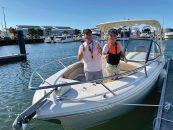The COLREGs is short-hand for the International Regulations for Preventing Collisions at Sea 1972, and they outline the internationally agreed rules for safe navigation of vessels, including the requirement to keep a look-out, travel at a safe speed, operation of vessels in narrow channels like rivers and also the ‘give way’ rules. The COLREGs apply pretty much everywhere in the world, including in Queensland waters; they are basically the traffic laws of the water.
At Pacific Maritime Lawyers, we often assist clients who have unfortunately been involved in a collision while out on their boat and we help with the aftermath. The consequences can range from dealing with insurers to determine fault for the collision, to managing criminal charges against our client for breach of the COLREGs, or assessing our client’s claim for physical injuries and losses, or in a worst case scenario, acting for the family of a deceased person.
To make sure you do not end up high and dry, take our quiz and ask your friends, family and fellow boaters to join in! How well do you know the ropes?
1. It is a beautiful summer’s day and you are out in your power-driven boat near South Stradbroke Island. You can see another power- driven boat approaching from your starboard side. Who has right of way?
a. The other boat has right of way.
b. Neither has right of way.
c. You have right of way.
The answer is ‘a’. If another boat is approaching your vessel from its starboard (right hand) side then the other boat will have right of way. This means that you must take action to avoid a collision with this other boat and give it plenty of sea-room.
2 You are just setting off for a day out on the waves in your power-driven boat. You can see a power-driven boat approaching that is on your port side. You are on the other boat’s starboard side so you have right of way and the other boat should give way to you. The other boat does not appear to be giving way. What should you do?
a. You don’t need to do anything. You should keep on going as you have right of way. It’s the other boat’s fault if they don’t stop for you.
b. Wave at the other boat and signal that you are proceeding on your course.
c. Take whatever action is needed to avoid a possible collision.
The correct answer is ‘c’. Even though you have right of way and the other boat should give way to you, if they do not appear to be doing so, you must take whatever evasive action is needed to avoid a collision. This includes changing course, but only to the starboard side, as if you change course to the port side this could place you in the path of the boat that is supposed to give way. Watch out. If you do not take any evasive action you are likely to be also held at fault for the collision even though the other vessel should have given way to you.
Remember! If the other boat is a larger vessel like a ferry or a container ship, the rule about giving way to the boat on the starboard side may not apply, especially if the larger vessel can only navigate within a narrow channel safely. Larger boats due to their size are more difficult to manoeuver and so the masters of smaller boats should use their common sense and give these larger vessels a wide berth.
3. You are on your way home from a great day out fishing with your mates. You live at Hope Island and need to sail down the Coomera River to get home. What side of the river should you sail on?
a. The starboard (right) side.
b. The port side (left).
c. Nobody is on the river now so you can sail on any side you want to.
The answer is ‘a’. A boat must always be navigated on the starboard side of a river or a narrow channel. Remember, you must not anchor your boat in a narrow channel.
4. The sun is shining, and you are on your way out for an afternoon in the boat with the family. You notice that another boat is approaching your boat head on. What should happen next?
a. The other boat should alter its course – you have right of way.
b. You should alter your course so that the other boat does not have to – then you know you are safe.
c. Both vessels should alter their course to starboard.
The answer is ‘c’. Both boats should alter their course to the starboard side so they can pass the other boat on the other boat’s port side.
5 You and your mates head out sailing for the weekend. Your mate notices another sail boat approaching your sail boat. Both sail boats have wind coming from different sides. You know that your sail boat has wind coming from the port side. Who should give way?
a. The other sail boat should give way to your sail boat.
b. You should give way to the other sail boat.
c. It depends on which direction the other sail boat is coming from.
The answer is ‘b’. When two sailing boats have wind on different sides, the boat with the wind on its port side must give way to the boat with the wind on the starboard side. If both sail boats have wind on the same side, the boat that is upwind (to windward) must give way.
6 It is the last day of the summer break and you are involved in a collision with another boat. You have minor injuries and there is some damage to the boat. You know you must report the collision to a shipping inspector. How long do you have to do this?
a. There is no time limit.
b. At the earliest opportunity within 48 hours after the owner or master of the boat becomes aware of the incident.
c. Within 24 hours after the owner or master of the boat becomes aware of the incident.
The answer is ‘b’. There is an obligation under section 125 of the Transport Operations (Marine Safety) Act 1994 (Qld) that ‘marine incidents’ must be reported at the earliest opportunity but within 48 hours of the owner (or the master) of the boat becoming aware of the incident, unless there is a ‘reasonable excuse’. A ‘reasonable excuse’ could be, for example, if the owner or master had sustained serious injuries and was unable to report the incident in the time frame set by the law. If the owner (or master) of the boat does not comply with this obligation and has no ‘reasonable excuse’, there is a costly penalty of up to $5,222.
So, how well do you know the ropes on the COLREGs? If you didn’t score too highly then make sure you brush up your knowledge before setting sail.
Finally, check out my 3 top tips for smooth sailing:
Always keep a proper lookout.
Always be prepared to take evasive action to avoid a collision; when in doubt, take action!
Know the COLREGs!
Give the team at Pacific Maritime Lawyers a call on 1300 797 627, they will be very happy to assist.
By Claire Strodder, Maritime Lawyer
Published in the Jan-Mar 2020 edition.



























